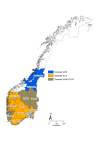No indication of Coxiella burnetii infection in Norwegian farmed ruminants
- PMID: 22607497
- PMCID: PMC3412698
- DOI: 10.1186/1746-6148-8-59
No indication of Coxiella burnetii infection in Norwegian farmed ruminants
Abstract
Background: Infection with Coxiella burnetii, the cause of Q-fever, has never been detected in Norwegian animals. Recognising the increasing prevalence of the infection in neighbouring countries, the aim of the study was to perform a survey of Norwegian farmed ruminants for the prevalence of C. burnetii infection.
Results: Milk and blood samples from more than 3450 Norwegian dairy cattle herds, 55 beef cattle herds, 348 dairy goat herds and 118 sheep flocks were serologically examined for antibodies against C. burnetii. All samples were negative for antibodies against C. burnetii. The estimated prevalences of infected herds were 0 (95% confidence interval: 0% - 0.12%), 0 (0% - 12%), 0 (0% - 1.2%) and 0 (0% - 10%) for dairy cattle herds, beef cattle herds, goat herds and sheep flocks, respectively.
Conclusions: The study indicates that the prevalence of C. burnetii infection in farmed Norwegian ruminants is low, and it cannot be excluded that Norway is free of the infection. It would be beneficial if Norway was able to maintain the current situation. Therefore, preventive measures should be continued.
Figures
Similar articles
-
Surveys on Coxiella burnetii infections in Swedish cattle, sheep, goats and moose.Acta Vet Scand. 2014 Jul 9;56(1):39. doi: 10.1186/1751-0147-56-39. Acta Vet Scand. 2014. PMID: 25007979 Free PMC article.
-
Genotyping of Coxiella burnetii from domestic ruminants in northern Spain.BMC Vet Res. 2012 Dec 10;8:241. doi: 10.1186/1746-6148-8-241. BMC Vet Res. 2012. PMID: 23227921 Free PMC article.
-
Seroprevalence of Coxiella burnetii in selected populations of domestic ruminants in Newfoundland.Can Vet J. 2002 May;43(5):363-4. Can Vet J. 2002. PMID: 12001502 Free PMC article.
-
Q fever and seroprevalence of Coxiella burnetii in domestic ruminants.Vet Ital. 2018 Dec 31;54(4):265-279. doi: 10.12834/VetIt.1113.6046.3. Vet Ital. 2018. PMID: 30681125 Review.
-
Coxiella burnetii infections in sheep or goats: an opinionated review.Vet Microbiol. 2015 Dec 14;181(1-2):119-29. doi: 10.1016/j.vetmic.2015.07.011. Epub 2015 Jul 15. Vet Microbiol. 2015. PMID: 26315774 Review.
Cited by
-
Coxiella burnetii Seroprevalence and Associated Risk Factors in Cattle, Sheep, and Goats in Estonia.Microorganisms. 2023 Mar 23;11(4):819. doi: 10.3390/microorganisms11040819. Microorganisms. 2023. PMID: 37110243 Free PMC article.
-
Role of Goats in the Epidemiology of Coxiella burnetii.Biology (Basel). 2022 Nov 25;11(12):1703. doi: 10.3390/biology11121703. Biology (Basel). 2022. PMID: 36552213 Free PMC article. Review.
-
Coxiella burnetii (Q fever) infection in dairy cattle and associated risk factors in Latvia.Epidemiol Infect. 2017 Jul;145(10):2011-2019. doi: 10.1017/S0950268817000838. Epub 2017 May 2. Epidemiol Infect. 2017. PMID: 28462725 Free PMC article.
-
Herd-level seroprevalence, molecular prevalence, and trends of Coxiella burnetii (Q fever) in cattle worldwide: A systematic review and meta-analysis.Vet World. 2024 Dec;17(12):2811-2828. doi: 10.14202/vetworld.2024.2811-2828. Epub 2024 Dec 18. Vet World. 2024. PMID: 39897364 Free PMC article.
References
-
- Krauss H, Weber A, Appel M, Enders B, Isenberg HB, Schiefer HG, Zoonoses. Infectious Diseases Transmissible from Animals to Humans. ASM Press, Washington DC; 2003. Bacterial zoonoses; pp. 173–252.
Publication types
MeSH terms
Substances
LinkOut - more resources
Full Text Sources


